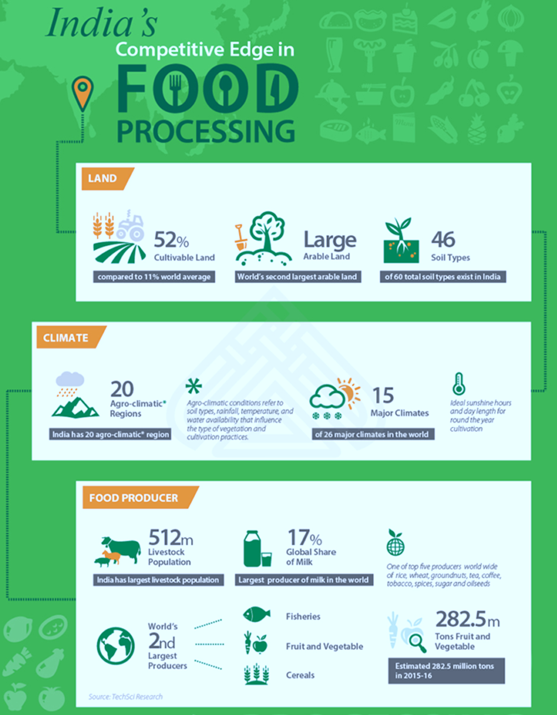QUES . Assess the prospect of food processing industry with suitable examples from India. UPSC IES/ISS EXAM 2022 General Studies . 200 Words . 5 Marks
HINTS:

India’s food processing sector, a brawny pillar of the Indian economy, has been booming in recent years. Holding a place among the largest food processing industries in the world, it is responsible for a significant portion – about 32 per cent – of India’s overall food market.
India, a bountiful land, has emerged as the second largest producer of agricultural goods and an abundant source of fruits and vegetables. Its dairy, marine, poultry, and meat industries are thriving and leading the world in production. Additionally, the Indian gourmet food market is rapidly expanding at a rate of 20 per cent annually.
Driven by the high-value processing of various agricultural products, increased urbanization, rising disposable incomes, the rise of nuclear families, and the demand for convenient food, India’s food processing industry is expected to reach a staggering $ 535 billion by 2026.
Prospects of food processing industry in India
Demand: With a population of more than 1.3 billion individuals and food constituting a major part of the consumer’s budget, this sector has a prominence next to no other businesses in the country.
Resilience: The importance of this sector to India’s economy becomes all the more relevant, considering the fact that this sector continued to perform well, despite fall in GDP number and poor performance by many other industries, during recession in 2008-09.
Value Chain: The industry encompasses a gamut of activities involved in reaching the final product to the consumer, starting with farming activity to produce inputs, processing of the inputs to create products and the associated supply chain involved in delivering the products.
Forward-Backward Linkages: It has increasingly come to be seen as a potential source for driving the rural economy as it brings about synergy between the consumer, industry and agriculture. A well-developed food processing industry is expected to increase farm gate prices, reduce wastages, ensure value addition, promote crop diversification, generate employment opportunities as well as export earnings. This sector is also capable of addressing critical issues of food security and providing wholesome, nutritious food to our people.
Scope for development: While the industry is large in terms of size, it is still at a nascent stage in terms of development. Out of the country’s total agriculture and food produce, only 2 per cent is processed. However, the contribution of food processing sector to GDP has been growing faster than that of the agriculture sector.
Raw material: Being an agrarian economy, there is sufficient supply of raw material in India. India ranks no. 1 in the world in the production of milk, ghee, ginger, bananas, guavas, papayas and mangoes. Further, India ranks no. 2 in the world in the production of rice, wheat and several vegetables & fruits. If the surplus production of cereals, fruits, vegetables, milk, fish, meat and poultry, etc. are processed and marketed both inside and outside the country, there will be greater opportunities for the growth of the sector.
Employment generation: It has the potential to generate non-farm employment, especially in rural areas. It would reduce disguise unemployment by providing productive employment opportunities.
Investments: There is 100 per cent FDI (foreign direct investment) allowed into the sector through the automatic route. The total FDI received in the food processing sector from April 2000 till September 2023 was $12.354 Bn which is 1.89% of the total FDI Equity inflow. The FDI equity inflow in the Food Processing Sector for FY 2023 was $0.896 Bn. These investments serves as a catalyst to boost agricultural income and employment.
What are the key initiatives taken to promote the food processing sector in India?
In order to enhance food processing infrastructure and generating employment, Ministry of Food Processing Industries (MoFPI) has been incentivizing setting up/expansion of related infrastructure through its two Central Sector Scheme Pradhan Mantri Kisan SAMPADA Yojana (PMKSY) and Production Linked Incentive Scheme for Food Processing Industry (PLISFPI) and a Centrally sponsored- Pradhan Mantri Formalization of Micro Food Processing Enterprises (PMFME) scheme across the country.
Key initiatives taken:
1 . Pradhan Mantri Kisan Sampada Yojana
2 . Mega Food Parks Scheme
3 . Integrated Cold Chain and Value Addition Infrastructure Scheme
4 . Operation Greens
5 . Creation of Backward and Forward Linkages Scheme
6 . PM Formalisation of Micro Food Processing Enterprises
7 . Production Linked Incentive Scheme for Food Processing Industry.
The industry is expected to continue its robust growth with the support of the government and the private sector. According to the Confederation of Indian Businesses (CII), three key factors will be crucial in the growth journey of India’s food processing industry: first, the establishment of strong backward links to ensure food security and to produce nutritious processed foods; second, improved access to financial resources; and third, cost competitiveness.
